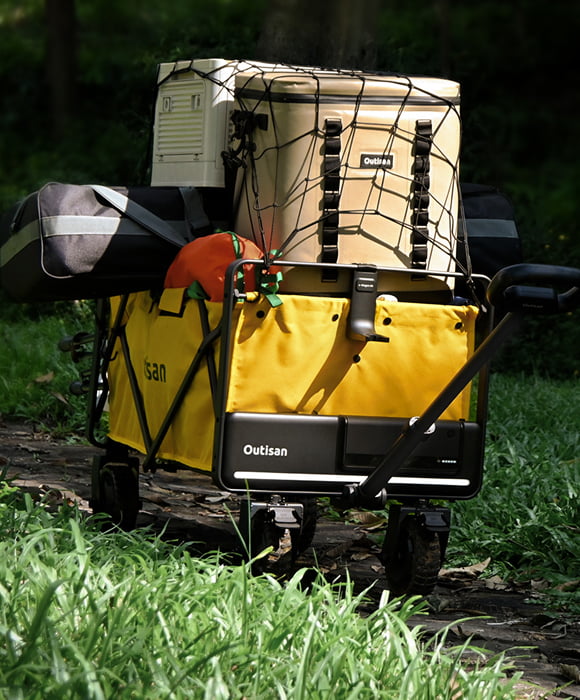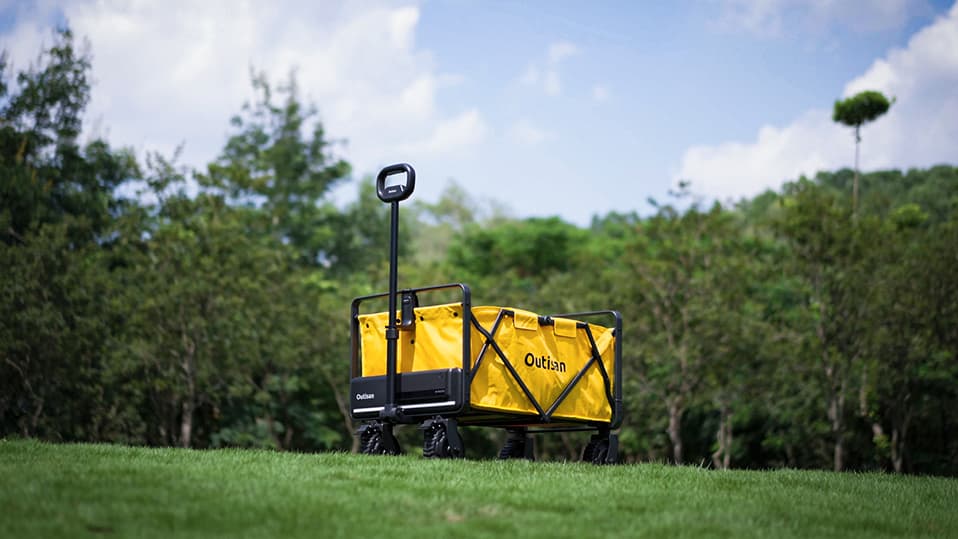
Why We Created an Electric Utility Wagon
The Outisan e-Wagon is the world's first electric utility wagon, combining tried-and-tested tech with modern innovation. And it's live now on Kickstarter. But is there really a need for an electric utility wagon? Let's find out!
Carts and wagons have been around for a long time. A really long time. Whether it's a cart, chariot, or modern-day wagon, we've been wheeling around gear for thousands of years. Our need for personal transportation has sparked innovation, from wheel spokes and full-rotational wheels all the way to elongated handles and foldable designs. But fast forward to the modern day, the current utility wagon has hit a roadblock. We've never gone electric. Until now.
A new dawn for utility wagons
Brands around the world are reinventing their business models with the aim of transitioning to a future of electric power. All it took was a passerby on an electric e-bike to get us thinking. Compared to a conventional bike, an e-bike offers more convenience when going uphill. And that's where things get interesting. Because when you apply that back to a utility wagon, people get tired of pulling things uphill, it's hard controlling the speed when going downhill, and it takes a lot of energy to pull your gear across uneven surfaces.
We spent hours in the Outisan forge, studying existing utility wagons when we came across an interesting find. Utility wagon patents date back to the 1890s, the industry has been tiptoeing along for the last 100 years or so.
We're unsatisfied. And you probably are too. Outdoor products have become generic, boring even. So we've decided to do something about it. We're a team of outdoor enthusiasts and consumer electronics experts, and we've decided to shake things up. For good.
Problems with conventional utility wagons
Conventional utility wagons just don't cut it. Here are some of the problems we set out to solve from the get-go.
Going uphill and downhill
Not only is it hard to go uphill, you have to control the speed of a utility wagon when going downhill. That's not ideal. Our first challenge was figuring out how to make downhill transportation safer, less chaotic, and less strenuous on your legs.
Limited useability
Over the past year, we've been amazed to see all the versatile ways people use utility wagons. Whether you're carrying your sports equipment, dining out in the wild, or playing a DJI set in a forest, a utility wagon enables you to do pretty much whatever you want. There is a slight problem though. Usability and convenience get a bit muddy when you start using your utility wagon across different terrains. Wagons are not really built or optimized for all-terrain use. Sure, plastic hollow tires run smoothly on flat grass and soft sand, but they make a lot of noise on the sidewalk. There has to be a better solution. And there is.
Getting caught in the dark
We spoke to a lot of people who use conventional utility wagons. After many conversations, we realized that many people struggled to carry their gear in the dark. We totally understand. We've had many camping experiences where we've got caught off guard, wandered off track, and forgot to bring adequate lighting. So we set out to deliver a more convenient utility wagon solution, come day or night.
They're boring
Let's face it — when you look at the design philosophy of wagons in the last century, there's one common denominator — they're dead boring. We went back to the drawing board and thought about all the ways people could use utility wagons. As it turns out, they're being used everywhere, from shopping trips to weekend camping trips. So we set out to design an e-Wagon that offers a seamless outdoor experience for a wide group of people.
Whether you're a natural-born adventurer or a weekend wilding, we produce beautiful outdoor products that help you feel at home in the wild or bring a touch of nature back home. It's totally up to you.
How does e-Wagon solve these problems?
Introducing FlowStride
We created FlowStride technology, an industry-first power assist mode that addresses the common issue of carrying heavy gear around. When you're going uphill, the e-Wagon motors kick in whenever you need a helping hand. Going downhill? Powerful motors control the speed of the e-Wagon, preventing it from sliding down a slope, and helping you cruise down without taking the strain on your legs. Compared to a traditional utility wagon, the pulling effort is significantly reduced, and that's exactly what we were going for.
Let there be light
Going electric opens up many doors. We fitted e-Wagon with front and back LED lights, so you can keep your path illuminated and remind people you're there. Gone are the dark days.
One wagon to rule them all
We opted for high-density rubber wheels that have a unique tread pattern, making them suitable for transportation across the backyard, parks, beaches, and pretty much anywhere. And we took it one step further. When coupled with our electric motors, our front-wheel-drive system offers a max power of 900W, which makes easy work out of different terrains.
A battery that keeps on going
There's no point going electric if it's inconvenient. We knew we had to design a portable, detachable, and rechargeable battery system. Whenever you need to charge up the e-Wagon, you can slide the battery off and charge up from home in just 3 hours. A full charge gives you up to 7 miles of usage. That's 7 miles of peace of mind.
Building the e-Wagon
So how exactly did we do it all? Going electric isn't as easy as it seems, especially when you're the first in the market to do it. Here are some stages we went through:
Market research
We spent ages conducting research, speaking to people, understanding their needs, and diving deep into product reviews. Good products are designed for people.
Defining the product
After we had a deep understanding of our target market, we started to map out and define e-Wagon features, paying particular attention to their priority. Along the way, we evaluated our innovation feasibility, product user experience, testing standards, and the cost of it all.
Industrial design
This was an exciting stage where we started to visualize what the e-Wagon would look like. We worked with award-winner, user-centric designers to create the entire wagon, piece by piece.
Structural Design
We spent a long time addressing user pain points through our structural design. For example, creating the folding mechanism, achieving an IP66 waterproof rating, and storing the sensors in a way that didn't interfere with the central control system.
R&D and suppliers
There's nothing quite like this on the market, which means components are hard to come by. We made a list of our key components, which includes the brushless motor, key sensors, control system, battery pack, and many more items. After mapping out our component list, we started finding suppliers. And even if there weren't any suppliers on the market, we went the full way to create the whole process ourselves. In some cases, we started from scratch, designing the components ourselves.
Electric control design
The e-Wagon is packed full of state-of-the-art electric components. We had to think carefully about the control system logic and the PCB layout. One particular challenge we had was trying to pass electric wires through the rotating part of the handle. We made adjustments and ran test after test, considering safety protection features, people's walking speed, and the adaptability of the FlowStride algorithm.
Testing every day
Our testing process took us everywhere. Roads, camping sites, backyards, beaches, you name it. We paid meticulous attention to e-Wagon's performance in different geographical locations, under different weather conditions.
So what's next?
We're continuously testing and building our 3rd prototype, identifying smaller issues and ironing them out before we go into mass production. At this stage, we're super confident in the e-Wagon, and we're pleased with its improvements compared to conventional utility wagons. So what's next? Once the prototype passes our strict assessment, we will initiate small batch production, continue field tests and third-party inspections, and start rolling out our certification process. Once we've cleared that, we'll start mass production.


